Kenneth L. Gentry Jr.'s Blog, page 5
May 9, 2025
STAND FIRM IN THE RESURRECTION HOPE (4)
PMW 2025-036 by Kenneth L. Gentry, Jr.
Introduction
This is my fourth article in a series of studies affirming, explaining, and defending historic Christianity’s view of the physical resurrection of the dead. I would encourage my current reader to look back at the preceding three installments of this series (and if you have a good Ouija board, you might want to look ahead to my future installments). I am demonstrating that 1 Corinthians 15 does not support the “spiritual-only body” view of ancient Gnosticism, modern liberalism, or contemporary semi-cultic hyper-preterism. These views hold that the resurrection body is a spiritual, ethereal entity rather than a fleshly, material one.
And without embarrassment I am declaring this alongside of centuries of sound Christian exegesis. Centuries of exegesis which continues on today despite the fact that Paul mentions a “spiritual body [Gk. soma pneumatikon]” in 1 Corinthians 15:44a.
Building the case
In my last article I noted the structure of Paul’s argument in paralleling and contrasting ideas as he is erecting his argument against his opponents. He is responding to a Hellenistic philosophy with proto-Gnostic features in Corinth. This proto-Gnostic tendency has raised a number of issues in Corinth which denigrate the material realm in deference to the spiritual realm. Consequently, in 1 Corinthians 15 Paul has to answer the incredulous questions found in v. 35: “How are the dead raised? And with what kind of body do they come?” So Paul has to carefully engage his opponents’ confusion and error by carefully structuring his case — at length.
Unto You and Your Children By Larry E. Ball
By Larry E. Ball
This book defines and illustrates the covenant as it appears in the Bible, and then demonstrates how the covenant affects our children as we raise them in the church. It also develops a justification for infant (covenant) baptism.
However, before the writer examines the idea of the covenant in the Bible, he first covers a number of other topics that a person needs to understand before he can understand the covenant. He spends at least one chapter revisiting the gospel. What is the gospel? He then establishes the meaning of such words as regeneration, conversion, election, and salvation. He is convinced that before a person can properly understand the covenant and covenant baptism there must be some agreement on the definition of these other terms.
See more study materials at: www.KennethGentry.com
I have been building on the exegetical labors of James Ware, David Garland, Andrew Das, E. Earle Ellis, N. T. Wright, Richard B. Gaffin, Jr., and others. I have argued that Paul engages in a well-structured literary presentation that carefully contrasts verbal pairs in vv. 36–49 (see last article). Having done that we can now make an important observation regarding Paul’s argument.
Upon noting Paul’s structuring (employing contrasting verb pairs in vv. 36–49), we can affirm the Westminster Confession of Faith’s view of our resurrection bodies. It states that at the last day the resurrection involves “the self-same bodies, and none other (although with different qualities), which shall be united again to their souls for ever” (WCF 32:2).
The subject matter
We can, along with the Church of all ages, easily see this in Paul’s well-structured presentation of our resurrection hope. For when we seek the subject of each of his verbal contrasts, we discover that they are the same for both the verbs denoting mortal death and the ones denoting resurrected life. That is, that which dies (the body) is that which arises again from death (the same body).
For instance, in v. 36 the mortal body that dies (the seed that is sown) is the very body that is “made alive.” In vv. 42–44 the single implied subject remains the same. That is, the “perishable body” is sown so that it may be “raised an imperishable body.” And Paul powerfully confirms this in v. 49 where he states that: “we have borne the image of the earthy [Adam], we will also bear the image of the heavenly [Jesus].” Something that is vitally important, yet too often overlooked, may be discovered in this chapter. And that is: the contrasts that Paul presents do not occur in the subjects but in the predicates. That is, the subject in the paired verbs in vv. 42–44 is the human body which is now perishable. But it will become imperishable through the transformative power of the resurrection.
In this regard we should note that Paul presents an illustration based on the life-cycle of the seed. This illustration shows that the very body that is sown is the one that is raised.
Before Jerusalem Fell Lecture
DVD by Ken Gentry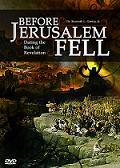
A summary of the evidence for Revelation’s early date. Helpful, succinct introduction to Revelation’s pre-AD 70 composition.
See more study materials at: www.KennethGentry.com
Thus, for the purpose of his argument against his “foolish” (v. 36a) opponents, the seed that is sown in death (vv. 36, 37, 38) is our earthly, mortal bodies (vv. 36–38). And the subject of these verbs remains the same when that sown mortal body then arises from death with new characteristics (imperishability, glory, and power) (vv. 42–44).
Consequently, Paul does not argue that the present body is sown in death but a new, different body arises in its place. Throughout his argument Paul remains focused on a single subject: the body that is sown in mortality is the very one raised in immortality, etc. It is the original body and not a different one; the thing that perishes is the very thing that arises again. This is why the key word for “resurrection” in Greek is anastasis. This word derives from anistemi, which means “stand up”: ana (“up”) + histimi (“to stand”). That which has fallen down, stands up again — not something else.
This body
This explains why in verses 53–54 Paul repeats four times that it is “this” (Gk., touto) body that is raised at the climax of his argument: “For this [touto] perishable must put on the imperishable, and this [touto] mortal must put on immortality. But when this [touto] perishable will have put on the imperishable, and this [touto] mortal will have put on immortality, then will come about the saying that is written, ‘DEATH IS SWALLOWED UP in victory.’” As Sider puts it “the subject persists throughout the radical change.”[1]
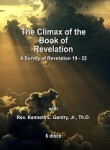 The Climax of the Book of Revelation (Rev 19-22)
The Climax of the Book of Revelation (Rev 19-22)
Six lectures on six DVDs that introduce Revelation as a whole, then focuses on its glorious conclusion. Provides an important, lengthy Introduction to Revelation also.
See more study materials at: www.KennethGentry.com
Orthodox Christianity believes that our fleshly body (created for us by God, Gen. 2:7; cp. Psa. 139:13) is included in God’s saving action, just as the unbeliever’s body is included in God’s judging action (Matt. 10:28). Though we have two parts (body and soul) we are a unified being. Both parts of our unified being are God-created and important. And objects of his blessed redemption.
There is more to come! Even so, come Lloyd Gentry (you might say).
Notes
1. Ronald Sider,“St. Paul’s Conception of the Resurrection Body in 1 Corinthians XV.35-54,” NTS 21 (1975): 438.
Click on the following images for more information on these studies:
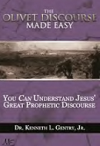

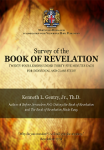
May 6, 2025
STAND FIRM IN THE RESURRECTION HOPE (3)
PMW 2025-035 by Kenneth L. Gentry, Jr.
This is my third study in a series on relevant portions of 1 Corinthians 15, which ancient Gnostics, modern liberals, and contemporary hyper-preterists believe support their attack on historic Christianity. They believe certain verses in this chapter undermine the historic doctrine of a future, physical, fleshly resurrection of the dead. And admittedly, upon a surface reading we can see how they could be confused by a few of Paul’s statements herein.
However, despite the surface appearance of some of Paul’s language (e.g., “spiritual body,” Christ as “life-giving spirit,” “flesh and blood cannot inherit the kingdom of God,” etc.), Christian orthodoxy has long held to the physical resurrection of the dead as a future, corporate eschatological event occurring at the end of history at the final judgment. And orthodox Christians have long been aware that Paul’s First Epistle to the Corinthians has been in the New Testament from very early in Christian history. Paul wrote it around AD 54, just 20+ years after Jesus’ death (it is one of the earliest New Testament canonical writings). And yet historic Christianity has still maintained the physical nature of our future resurrection.
The Foundation of Paul’s Argument
The debate over the nature of our resurrection bodies should be quickly resolved by simply reading Paul’s opening comments in 1 Corinthians 15:1–23. These words demonstrate that resurrection is truly a physical reality involving the revivification of the deceased body made of flesh. These opening words focus on the reality of Jesus’ own physical, fleshly resurrection from the dead (e.g., Luke 24:39; John 20:1-12, 20, 27; Acts 2:26, 31). And according to Paul, that event was rooted in Scripture itself (v. 4) and historically attested by human witnesses (vv. 5–8). And he also informs us of its linkage to our own resurrection, so that Jesus’ resurrection functions as the first-fruits of ours (vv. 20, 23).
[image error]For more information and to order click here.
" data-image-caption="" data-medium-file="https://postmillennialworldview.com/w..." data-large-file="https://postmillennialworldview.com/w..." class="alignright size-full wp-image-211" src="https://postmillennialworldview.com/w..." alt="" />Perilous Times: A Study in Eschatological Evil (by Ken Gentry)
Technical studies on Daniel’s Seventy Weeks, the great tribulation, Paul’s Man of Sin, and John’s Revelation.
See more study materials at: www.KennethGentry.com
And most significantly, Paul declares that Jesus’ physical resurrection serves as the very heart of the gospel of our salvation (vv. 1–4). This is why re-interpreting the resurrection (of Jesus — and ourselves) leads into heretical territory.
Paul uses his opening words in 1 Corinthians 15 to discuss Jesus’ past bodily resurrection. He does this in order to lay the foundation for his sustained argument regarding our future bodily resurrection. Significantly, the believer’s resurrection is actually his main topic in this large chapter. We see this not only from the space he affords the matter (see vv. 13–54), but also because he is answering the specific questions held by some of the Corinthians (v. 35).
And Paul presents these questions as designed by his opponents to dismiss and even to mock (!) the very idea of the resurrection. For after all of his previous lengthy, detailed discussion of Christ’s resurrection, its importance to salvation, and the proofs of its having occurred, Paul then introduces their questions with the strong adversative (Gk., alla). Thus, his opponents strongly rejected the very possibility of resurrection, leading him to respond immediately with: “You fool!”
So, Jesus’ own resurrection serves as the foundation of his rebuttal to the proto-Gnostic problem at Corinth. From this chapter and verses elsewhere, we know Jesus’ resurrection was a physical reality (e.g., Luke 24:38–39; John 20:19–20, 25, 27). In fact, early on in his ministry Jesus openly declared: “Destroy this temple, and in three days I will raise it up,” which was a reference to his currently inhabited body (“this temple”) dying and (“it”) rising again (John 2:19–21).
So then having opened thusly, Paul immediately brings the reality of Jesus’ resurrection to bear on the question of the believer’s resurrection. In fact, the heart of his concern in this lengthy chapter is to answer the proto-Gnostics’ two questions in v. 35. Let us see how Paul answers the problem presented by his opponents. I will begin by first considering:
The Structure of 1 Cor. 15:36–54
Professor James Ware has presented us with a valuable analysis of the structure of this section of Paul’s epistle.[1] He shows the implications of the literary framework of Paul’s argument for our physical resurrection. I will be following his lead, which is a great example of careful, sound exegetical analysis. (The only problem with his argument is he happens to believe what historic Christianity has always believed, which makes him suspect and renders him naive to some novel theologues roaming the Internet.)
Postmillennialism Made Easy (by Ken Gentry)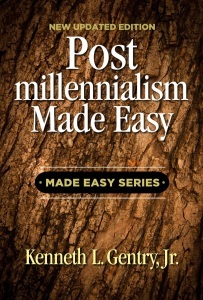
Basic introduction to postmillennialism. Presents the essence of the postmillennial argument and answers the leading objections. And all in a succinct, introductory fashion.
See more study materials at: www.KennethGentry.com
Paul engages the matter before him by carefully structuring his answer for maximum impact. In the first part of his argument (vv. 36–49), he pairs opposing verbs that refer to death and to resurrection. Then in the second part, he drops the paired negative and positive verbs, and begins using seven verbs speaking of resurrection/transformation (vv. 50-54).
In the first part of his response, he employs these twelve verbs presented in six pairs:
apothane (“dies”) / zoopoieitai (“made alive”) (v. 36)
speiretai (“sown”) / egeiretai (“raised”) (v. 42)
speiretai (“sown) / egeiretai (“raised”) (v. 43a)
speiretai (“sown) / egeiretai (“raised”) (v. 43b)
speiretai (“sown) / egeiretai (“raised”) (v. 44).
ephoresamen (“we bore”) / phoresomen (“we shall bear”), v. 49
These paired verbs present a series of contrasting results distinguishing the believer’s present earthly body from his future risen body:
“dies” / “made alive” (v. 36)
“perishable” / “imperishable” (v. 42)
“dishonor” / “glory” (v. 43a)
“weakness” / “power” (v. 43b)
“natural body” / “spiritual body” (v. 44)
“earthy” / “heavenly” (v. 49)
Then after this back-and-forth with paired opposing verbs, things change (no pun intended) at v. 50. Verse 50 warns that “flesh and blood cannot inherit the kingdom of God, nor does the perishable inherit the imperishable.” Then his stylistic change of approach is presented in verses 51ff.
So now at this point Paul begins using only verbs that speak of our glorious resurrection or transformation (vv. 50–54). Those verbs are: allagsometha (“we shall be changed”) (vv. 51 and 52); egerthsontai (“shall be raised”) (v. 52); endusasthai (“shall put on”) (vv. 53–54; 4x).
By doing this Paul forms a literary inclusio which brackets the whole section. That is, he presents the substantives (i.e., nouns or noun phrases) of verses 53–54 (phtarton [“perishable”]/aphtharsian [“imperishable”]; theton [“mortal”]/aphtharsian [“immortal”]) to echo the verb pairs in verse 42 (“sown a perishable body”/“raised an imperishable body”).
Not only so, but we must note that the first substantive pair (“perishable/imperishable,” vv. 53–54) matches the first verbal pair (“perishable/imperishable,” v. 42). This is not accidental; this is strategic. Paul is drawing our attention to his goal of exalting our physical resurrection glory. Significantly, the final substantive pair (athanasia, “immortality,” 2x in v. 54a) opens the door, leading to his grand conclusion — that “death is swallowed up in victory (v. 54b).
Predestination Made Easy
(by Ken Gentry)
A thoroughly biblical, extremely practical, and impressively clear presentation of
the doctrine of absolute predestination.
See more study materials at: www.KennethGentry.com
All of this underscores the fact that our natural, fallen, weak, flesh-and-blood bodies cannot just walk into eternity. They must be transformed by divine action — at the resurrection. And Paul is describing that transformation which makes our “raised” (v. 52), physical bodies, imperishable and immortal (vv. 53–54).
So now we must observe that the opposing verb pairs in vv. 36–49 involve the very same body (“self-same” body as the Westminster divines put it) in both parts of the opposing conditions. That which dies (the body) is made alive. That which is sown in mortality (the body) is raised in immorality. This transformation to immortality involves a fundamental continuity of bodily substance.
There is more for us to consider. See you next time.
Notes
1. James Ware, The Final Triumph of God; see also David E. Garland, 1 Corinthians (BECNT).
GOODBIRTH AND THE TWO AGES
I am currently researching a technical study on the concept of the Two Ages in Scripture. This study is not only important for understanding the proper biblical concept of the structure of redemptive history. But it is also absolutely essential for fully grasping the significance of the Disciples’ questions in Matthew 24:3, which spark the Olivet Discourse. This book will be the forerunner to a fuller commentary on the Olivet Discourse in Matthew’s comprehensive presentation. This issue must be dealt with before one can seriously delve into the Discourse itself.
If you would like to support me in my research, I invite you to consider giving a tax-deductible contribution to my research and writing ministry: GoodBirth Ministries. Your help is much appreciated!
May 2, 2025
STAND FIRM IN THE RESURRECTION HOPE (2)
 PMW 2025-034 by Kenneth L. Gentry, Jr.
PMW 2025-034 by Kenneth L. Gentry, Jr.
This is the second in my series discussing 1 Corinthians 15 as it regards the resurrection of the dead. Having thoroughly rebuked the heretical party at Corinth, Paul urges them (and all Christians) to “stand firm. Let nothing move you” (1 Cor. 15:58) from this resurrection hope, as he comes to the grand finale of his letter. This chapter happens to be the Achilles Heel (one among many!) of hyper-preterism and its assault on historic Christianity.
I will be focusing on key verses in Paul’s great “Resurrection Chapter,” though not exegeting the entirety of this lengthy chapter. And I will be concerned (as Paul was) with the believer’s resurrection rather than the unbeliever’s, though Paul held to the resurrection of both (Acts 23:6; 24:15), as did his Lord (John 5:25–29).
An Important Opening Issue
One area of the hyper-preterist’s debate with historic Christian theology has to do with the nature or composition of the resurrection body. That is, whether it will be material or spiritual, whether tangible or ethereal. And I will get to that issue at the appropriate time (right now it is 11:27 am on the day I am writing this, and I am hungry for lunch, but I digress).
The first issue regarding the resurrection that I will deal with, though, will be an often overlooked but a more basic and important one. I will focus on the foundational question underlying the issue before us. And that question is: at the resurrection, will God be creating an altogether new body for the believer that is not the one in which he lived during his earthly sojourn? Or will God be reconstituting and reviving the flesh-and-bones body in which the believer actually dwelled while on earth — or on the moon or Mars, or wherever he might be at the time his death (depending on Elon Musk’s success back in the 21st century [I’m looking ahead now, so that I can look back]), transforming it into an imperishable material body made suitable for eternity.[1]
Three Views on the Millennium and Beyond
(ed. by Darrell Bock)
Presents three views on the millennium: progressive dispensationalist, amillennialist, and reconstructionist postmillennialist viewpoints. Includes separate responses to each view. Ken Gentry provides the postmillennial contribution.
See more study materials at: www.KennethGentry.com
Thus, we have before us this fundamental question: Is the divine work of resurrection a creative action, or is it a transformative one? Then as a consequence, is the resurrection body a new and different body or is it a restored and improved one? That is, will the resurrection be more along the lines of Pharisaic Judaism’s belief in the material resurrection of the flesh? Or will it be more like the Gnostic view that dismisses the material in preference to the spiritual? So, as the famed liberal scholar James D. G. Dunn expressed the issue at debate: “The real debate is whether Paul conceived of the resurrection body in terms of a reconstitution of the flesh.”
Historically, the Christian view (as seen in the historic ecumenical creeds which summarize the biblical doctrine) has followed the path of the first-century mainline Jewish belief. This is despite the efforts of Valentinus (ca. 100–180) and Origen (ca. 185–253) to promote a spiritual-body view. This spiritual-body doctrine has long lain in the dustbin of history until resurrected (!) by modern liberalism, such as promoted by Otto Pfleiderer (1877) and Ernst Teschmann (1896).
The Internal Issues Involved
According to the spiritual-body advocates, Paul held that our resurrection will liberate us from the present fleshly body which has characterized us as humans from the beginning (Gen. 2:7). Indeed, on this view the resurrection also frees us from our material earthly existence so that we can dwell as spirits in heaven forever.
However, Paul teaches something quite different — as does that darn, confounded historic Christianity! Here in 1 Corinthians 15, he teaches that our resurrection will restore our earthly material bodies to us. But it will do so while simultaneously liberating us from the power of death, and freeing our bodies from the prospect of dishonor, weakness, and perishability (vv. 42–43). And consequent upon this, the renewed, transformed creation-order will become our eternal home (Rom. 8:21–22; 2 Pet. 3:10–13).
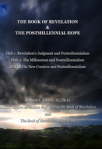 The Book of Revelation and Postmillennialism (Lectures by Ken Gentry)
The Book of Revelation and Postmillennialism (Lectures by Ken Gentry)
In the first of these three 50-minute lectures Gentry explains Revelation’s judgments to show they do not contradict postmillennialism. In the next two lectures he shows how the Millennium and the New Creation themes strongly support the gospel victory hope found in postmillennialism.
See more study materials at: www.KennethGentry.com
Consequently, this whole debate involves matters far beyond what most laymen traditionally believe regarding “eschatology” (i.e., the very last things of history). Biblical eschatology actually begins before the beginning! For God has chosen us before the foundation of the world (Matt. 25:34; Eph. 1:4; Rev. 13:8; 17:8) and initiated and begins guiding our eschatological salvation immediately upon Adam’s fall into sin (Gen. 3:15). Therefore, Paul’s eschatological resurrection impacts Christology and anthropology, as well as eschatology-proper.
Conclusion
As I continue this series, I will flesh out (no pun intended) Paul’s physical resurrection doctrine more fully. I will demonstrate that Paul does not mean what the hyper-preterists and Gnostics think he means by our receiving a “spiritual body” (1 Cor. 15:44) and of Christ’s becoming “a life-giving spirit” (v. 45). Nor do they properly understand what he means when he says “flesh and blood cannot inherit the kingdom of God” (v. 50).
Of course, you could just look up almost any evangelical commentary and find the proper understanding of these issues, but that would be too easy. You would be especially helped by Reformed biblical theology, as taught by Geerhardus Vos, Richard B. Gaffin, Jr., Greg L. Bahnsen, and many other Reformed theologians. But I hope you will come back to my website, since most Reformed and evangelical scholars do not bother with hyper-preterism.

The Book of Revelation Made Easy
(by Ken Gentry)
Helpful introduction to Revelation presenting keys for interpreting. Also provides studies of basic issues in Revelation’s story-line.|
See more study materials at: www.KennethGentry.com
Notes
1. For the question as to whether it is entirely too difficult for Almighty God, Maker of Heaven and Earth, to remake the wasted-away body of a person arise from the dead, see Robert L. Dabney’s study of the matter, found at: PMW 2025-020 and PMW 2025-021. Or go to: https://postmillennialworldview.com/?s=dabney&submit=Search
Thus, while our resurrection follow the pattern of Job’s expectation: “I know that my Redeemer lives, / And at the last He will take His stand on the earth. / Even after my skin is destroyed, / Yet from my flesh I shall see God; / Whom I myself shall behold, / And whom my eyes will see and not another.” (Job 19:25–27)
April 29, 2025
STAND FIRM IN THE RESURRECTION HOPE (1)
PMW 2025-033 by Kenneth L. Gentry, Jr.
In 1 Corinthians 15:58, we reach Paul’s argumentative conclusion to 1 Corinthians. This verse closes out the great resurrection chapter upon which Paul exhorts: “Therefore, my dear brothers and sisters, stand firm. Let nothing move you” (NIV). Standing firm on the resurrection has been the historic commitment of orthodox Christianity for 2000 years. However, recently not only has liberalism undercut the resurrection, but so has the semi-cultic hyper-preterist movement.
Unfortunately, the hyper-preterist movement, as Hal Lindsey may have expressed it (until his recent change of eschatology), is alive and well on Planet Earth. It is actively at work rejecting and/or re-working long-held eschatological doctrines, but not silently and in a corner. Rather they do so activistically publicly promoting their various (growing number of) heresies. This tragedy has arisen due to a very prideful error: the replacing of sola Scriptura (Scripture alone) with solo Scriptura (I alone am the interpreter of Scripture). “I know more than the church of all ages; I do not have to stand on the shoulders of giants.”
Defining hyper-preterism is difficult in some respects. This is because there are several main camps with widely divergent views of crucial defining features. But at the very heart of the matter, hyper-preterists are (in one way or another) rejecting three of the key issues highlighted in biblical eschatology: (1) the future, bodily second coming of Christ, (2) the material, eternal, bodily resurrection of the dead, and (3) the final judgment of all men that ends history. These are the very issues a group of theological friends of Gary DeMar put to him, seeking a simple yes or no answer regarding whether or not he accepted them. He declined to answer with a yes or no. W
The Hyper-preterist Menace
The eschatological error in hyper-preterism is bad enough. But as they are being swept along by their cheering converts in a classic stage-diving act, their innovative ideas are beginning to erode broader Christian doctrines in their Internet chat-rooms. Such accelerating expansion of theological error should be expected since theology is a seamless garment, as Cornelius Van Til has taught us. Thus, the ripping out of these few (rather large!) eschatological threads starts a process of unraveling other areas of the rich tapestry of biblical theology. Tragically, hyper-preterists are systematically destroying systematic theology.
Have We Missed the Second Coming: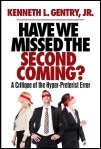
A Critique of the Hyper-preterist Error
by Ken Gentry
This book offers a brief introduction, summary, and critique of Hyper-preterism. Don’t let your church and Christian friends be blindfolded to this new error. To be forewarned is to be forearmed.
For more Christian educational materials: www.KennethGentry.com
By this I mean that they are reworking several theological loci such as Christology, soteriology, anthropology, cosmology, and more. For instance:
(1) Regarding Christology, many of their leaders deny the ongoing incarnation of Christ. They reject the truth that he is permanently the Son of Man, always possessing the body and soul in which he was incarnated (Col. 2:9). That he continues in his incarnation is seen in his submitting to God the Father at the end of history (1 Cor. 15:28). He does not do this as his co-equal in his divine nature, but in his incarnate state as the God-Man, who is our Mediator with God because of his incarnation (1 Tim. 2:5). [2] They claim that at his ascension, Jesus shed his physical body. They do this without any exegetical warrant, mind you. This is forced on them by their own erroneous theological requirements.
(2) Regarding soteriology and anthropology, they also reject the fullness of personal redemption. They do this by forgetting that God made man with both a material body (flesh) and spiritual soul (Gen. 2:7). Thus, in Scripture and orthodox Christianity, both body and soul are the objects of either redemption (Rom. 8:19, 23) or condemnation (Matt. 10:28).
(3) Regarding cosmology, they also deny the full, final redemption of the God-created universe as the goal of Christ’s redemptive work which results from God’s redemptive plan (Rom. 8:20–21; 1 Cor. 15:27–28), leaving God with a universe forever corrupted by sin and in rebellion against him. And more! And by the way, that redemptive plan began at the fall in Eden (Gen. 3:15). It did not await the arising of Abraham (Gen. 12).
Eventually they should be able to write a Systematic Anti-theology when they complete their destructive overhauling of the Christian faith — a work in progress on the Internet, even as we speak.[1] Hyper-preterist theologues have attempted to design a horse, but have ended up with a camel. Which for them might actually be quite helpful as they wander through the barren wilderness of unsettled theological territory. Sadly, they are selling their Christian birthright for a pot of message.
Reformed Eschatology in the Writings of Geerhardus Vos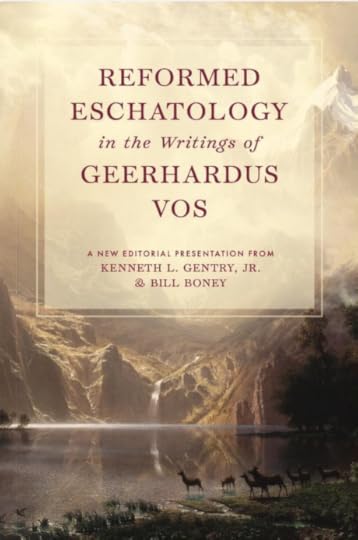
Ed. by Ken Gentry and Bill Boney
This is a collection of several key eschatological studies by the renowned Reformed theologian Geehardus Vos. We have modernized Vos’ grammar and syntax and updated his layout style according to modern publishing conventions (shorter sentences and paragraphs). We did this without changing any of Vos’ arguments.
For more information on this new Vos work or to order it, see:
https://www.kennethgentry.com/reformed-eschatology-in-the-writings-of-geerhardus-vos/
My Particular Concern
The particular error that I will be focusing on in this mini-series, however, will be narrow. I will exegetically demonstrate the nature of the resurrection body, which involves the fullness of our redemption. I will be theologically affirming and exegetically defending the doctrine of the physical, material, fleshly resurrection of the dead at the future return of Christ.
Surprisingly, I hold to the Statement of Faith on eschatology of DeMar’s employer, American Vision. That brief statement reads in part:
“We believe in the personal, bodily return of our Lord Jesus Christ at the consummation of history. The dead, consisting of believers and non-believers, shall be raised up in final judgment. Those who are saved shall be raised up unto everlasting life and those who have rejected Christ unto eternal damnation” (see: Statement of Faith).
Unfortunately, this brief Statement of Faith does not state the matter fully enough (by the very nature of the case, creedal statements, cannot cover everything — so this is not a complaint, but simply an observation). But the AV Statement does clearly hold to “the personal, bodily return of our Lord Jesus Christ,” noting that it has not yet occurred (at AD 70 or any other time) because it is awaiting “the consummation of history.” Two views which DeMar himself no longer affirms as matters of biblical revelation.
And the AV Statement also states that “the dead, consisting of believers and non-believers, shall be raised up in final judgment.” This part of the Statement obviously holds that it has not happened yet for it awaits the time in the future when they “shall be raised up.” And this affirms the corporate nature of the resurrection, rather than individualistic-at-the-moment-of-death view. Yet, this Statement does not touch on the nature of the resurrection body that lies in our future. Yet what this Statement does affirm is something which DeMar no longer holds. For he believes we receive our resurrection bodies (bodies composed of spirit rather than matter) at the moment of our individual deaths in history.
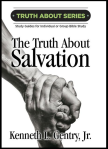 The Truth about Salvation By Ken Gentry
The Truth about Salvation By Ken Gentry
A study guide for personal or small group Bible study. Deals with the Christian doctrine of salvation from a Reformed theological perspective. It opens with a study of God as loving Creator, the shows how the first man fell into sin. Shows God’s righteousness requires that sin be dealt with. Presents Jesus as both God and man so that he can be man’s Savior. Includes review questions and questions for further study.Twelve chapters are ideal for one quarter of Sunday School.
See more study materials at: www.KennethGentry.com
Conclusion
In this series I will be providing an important exegetical analysis of key portions of 1 Corinthians 15, showing that these do not contradict historic Christian orthodoxy but effectively deny heretical hyper-preterism. I will be dealing with the key issues that trip up the hyper-preterist causing them to stumble off in the wrong direction. In fact, I will be answering the questions that Paul is answering from the proto-Gnostic members of the church at Corinth: “But someone will say, ‘How are the dead raised? And with what kind of body do they come?’” (1 Cor. 14:35).
So, along the way we will see what Paul means by “spiritual body” (v. 44), by Christ having become a “life-giving spirit” (v. 45), and his declaring that “flesh and blood cannot inherit the kingdom of God” (v. 50). These few words in this long and important passage have confused some believers, causing them to become “children, tossed here and there by waves and carried about by every wind of doctrine, by the trickery of men, by craftiness in deceitful scheming” (Eph. 4:14).
GOODBIRTH AND THE TWO AGES
I am currently researching a technical study on the concept of the Two Ages in Scripture. This study is not only important for understanding the proper biblical concept of the structure of redemptive history. But it is also absolutely essential for fully grasping the significance of the Disciples’ questions in Matthew 24:3, which spark the Olivet Discourse. This book will be the forerunner to a fuller commentary on the Olivet Discourse in Matthew’s comprehensive presentation. This issue must be dealt with before one can seriously delve into the Discourse itself.
If you would like to support me in my research, I invite you to consider giving a tax-deductible contribution to my research and writing ministry: GoodBirth Ministries. Your help is much appreciated!
Notes
1. I confess that I not only move my lips as I type but I also speak aloud. In fact, I sometimes do so with an acoustic megaphone. But my wife is glad that I at least quit yodeling in my I sleep.
2. It has been well-stated that: “The Son of God became the Son of Man, so that the sons of men might become the sons of God.”
April 25, 2025
MATTHEW 22, MARRIAGE, AND ETERNITY
 PMW 2025-032 by Michael Allen
PMW 2025-032 by Michael Allen
Gentry note:
The following discussion is taken from Michael Allen’s contribution to Michael Whittmer, ed., Four Views on Heaven published by Zondervan and available on Amazon. I found this material on pages 124–25 helpful as I am working on my Two Ages book. I will be dealing with Matthew 22 and Jesus’ rebuke of the Sadducees regarding marriage and eternity. You will have to see the book to get the full text and footnotes.
Michael Allen writes:
It has been asked: How will we relate to our spouses and other family members? Will there be marriage, sex, or family units in our final state? Will we remain gendered, and if so, will we wear clothes? It may be helpful to begin reflection elsewhere, to use this question as a teaching moment for a wider principle. Likely no text has so generated eschatological speculation as has Isaiah 60:5, 9 with its reference to the ships of Tarshish bringing treasures into the storehouse of Zion. Many that here is warrant for confidence that the aesthetic or productive triumphs of society will persist into the eschaton. Labor invested in earthly affairs has value not only for today but bright hope for tomorrow too.
Perhaps so. Yet confidence that we have some concrete sense of what it means for life and its blessings today to persist into the eschaton ought to be chastened. The most basic element of human life that will persist is the interpersonal set of relations that make up our human existence (as brother and sister, as father and mother, etc.). But it is just here that the Bible punctures any sense of clear transference from this life to the next.
Reformed Eschatology in the Writings of Geerhardus Vos
Ed. by Ken Gentry and Bill Boney
This is a collection of several key eschatological studies by the renowned Reformed theologian Geehardus Vos. We have modernized Vos’ grammar and syntax and updated his layout style according to modern publishing conventions (shorter sentences and paragraphs). We did this without changing any of Vos’ arguments.
For more information on this new Vos work or to order it, see:
https://www.kennethgentry.com/reformed-eschatology-in-the-writings-of-geerhardus-vos/
The most fundamental relational building block of our is surely human marriage, wherein companionship and the propagation earthly life of children find their appropriate place. Yet marriage will not occur in the eschaton (Matt 22:30). While the first clause might be read as merely limiting any new marriages (“they neither marry nor are given in marriage”), the adversative presses further to speak of a non-erotic life that no longer expresses itself sexually (“like angels in heaven”). Marriage is not abrogated so much as fulfilled in that the great marriage supper of the Lamb will have occurred and the eschatological union of Christ and his bride will have taken place.
How shall we understand that line from Matthew 22 and its implications for marriage? Interpreting this biting statement (part of Jesus’s polemic against the Sadducees [Matt 22:23– \33]) canonically, we see that marriage does not end in eternity. Rather, marriage is perfected, in as much as the great marriage of the Lamb and his bride is celebrated there and then (Rev 21:9). The fellowship and oneness symbolized so powerfully in the earthly marriage of a man and woman (see Eph 5:25–33, esp. v. 32) need no longer occur because its typological fulfillment has been fully and finally brought to pass in the definitive identification, union, communion, and covenant fellowship of Christ with his church.
Thine Is the Kingdom
(ed. by Ken Gentry)
Contributors lay the scriptural foundation for a biblically-based, hope-filled postmillennial eschatology, while showing what it means to be postmillennial in the real world.
See more study materials at: www.KennethGentry.com
The perfection of marriage serves as an intellectual prompt for thinking about the social facets of our eschatological hope more broadly. On the one hand, we see the deepest purpose of human marriage being transposed into the ultimate divine-human covenantal fellowship and intimate presence. Thus, our current commitment to marriage has integrity and deserves our concern and commitment (whether directly or indirectly), precisely because it prepares for and is perfected in eternity to come. On the other hand, marriage will no longer exist in its current social form. It will no longer be marked by sexual activity, by procreation as a related end, and so forth. If marriage’s perfection involves such radical changes to its reality, ought we not be humble in our presumptions, much less pontifications, about what other social realities might be like in that new-creational hereafter?
In light of these examples — the bodily nature of human glory (as seen in Jesus) or the social nature of human glory (as foretold with regard to marriage by Jesus) — we do well to keep our eyes on broader theological principles. Our concern to keep first things first need not and should not undermine our simultaneous commitment to be alert to other facets of canonical teaching. Emphases and priorities cannot foreclose awareness of the breadth of scriptural teaching. In this case, understanding the center of our hope as communion with God in Christ (so powerfully typified by that doctrine of the beatific vision) ought not lead to dismissing or denigrating the earthy aspect of our hope as one involving a bodily resurrection and a new creation in its holistic totality. That said, that other aspects of this broad eschatological vision are not at the center but on its edges should prompt a greater appreciation for the epistemological limits of our understanding of their nature. Without undermining the integrity of bodies, of sociWeties, of place, and of other nonhuman creatures, we must remember that there are limits to our grasp of their final form. Eschatology, like other doctrines but in a particularly poignant way, must be pursued by faith and by faith alone.
GOODBIRTH AND THE TWO AGES
I am currently researching a technical study on the concept of the Two Ages in Scripture. This study is not only important for understanding the proper biblical concept of the structure of redemptive history. But it is also absolutely essential for fully grasping the significance of the Disciples’ questions in Matthew 24:3, which spark the Olivet Discourse. This book will be the forerunner to a fuller commentary on the Olivet Discourse in Matthew’s comprehensive presentation. This issue must be dealt with before one can seriously delve into the Discourse itself.
If you would like to support me in my research, I invite you to consider giving a tax-deductible contribution to my research and writing ministry: GoodBirth Ministries. Your help is much appreciated!
April 22, 2025
HEAVENLY JOY DESPITE EARTHLY LOSS
 PMW 2025-031 by Peter Kreeft
PMW 2025-031 by Peter Kreeft
Gentry note:
As I am researching my book on the Two Ages of redemptive history, I am reading a lot of material — some useful for my work, some not (at least directly) useful. This is an interesting clip from Zondervan’s Four Views of Heaven book by Roman Catholic philosopher Peter Kreeft. This is from pp. 172–74 in the Zondervan “Views” book. Surprisingly, it should be insightful and encouraging to Reformed believers. This book (with all its footnotes that I have left out!) is available from Amazon.
Peter Kreeft: “Will we remember tragic events of this life?”
8. Will We Remember Tragic Events of This Life? And Will We Remember and Regret the Absence of the Loved Ones Who Are Not with Us in Heaven because They Are in Hell?
These are two quite different questions. Let’s answer the last and hardest one first.
The question is a trilemma. If we will not regret their absence because we will not remember them, then our happiness would depend on our ignorance of the truth that they are in hell. If we will remember them but not regret their absence, then our happiness would depend on our lovelessness. But truth and love are the two divine and heavenly absolutes. And if we will remember them and regret their absence, then a third heavenly absolute would be sacrificed, namely, joy.
C. S. Lewis answers this trilemma — a truly difficult and worrisome one — in The Great Divorce, first by proving that the answer must be that we will have no loss of joy or love or truth. However God does that, we will do it too. The facts are certain and clear, even though the explanation of how that can work is not. For heaven cannot meet “the demand of the loveless and the self-imprisoned (in hell) that they should be allowed to blackmail the universe; that till they consent to be happy (on their own terms) no one else shall taste joy: that theirs should be the final power; that hell should be able to veto heaven. . . . Either the day must come when joy prevails and all the makers of misery are no longer allowed to infect it, or else forever and ever the makers of misery can destroy in others the happiness they reject for themselves.”
God’s Law Made Eas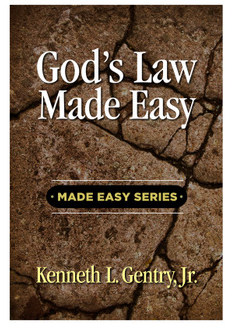 y
y
(by Kenneth Gentry)
Summary for the case for the continuing relevance of God’s Law. A helpful summary of the argument from Greg L. Bahnsen’s Theonomy in Christian Ethics.
See more study materials at: www.KennethGentry.com
Lewis then explains how this can happen, applying St. Thomas’s distinction between activity and passivity, or act and potency, to the affection of pity or compassion:
“The action of Pity will live forever, but the passion of Pity will not. The passion of Pity, the Pity we merely suffer, the ache that draws men to concede what should not be conceded and to flatter when they should speak truth, the Pity that has cheated many a woman out of her virginity and many a statesman out of his honesty-that will die. It was used as a weapon by bad men against good ones: their weapon will be broken. [But the action of Pity is] a weapon on the other side. It leaps quicker than light from the highest place to the lowest to bring healing and joy…. Every disease that submits to a cure shall be cured, but we will not call blue yellow to please those who insist on still having jaundice.”
Even in this life we can distinguish these two aspects of pity or compassion, even though they are always mingled together. When someone we love does something self-destructive, we say, “How could you do that to yourself?” This is active compassion, pure and unselfish charity. But there is always also an undertone of, “How could you do that to me?” And that is passive and self-centered pity. We cannot and should not try to separate these two aspects in this life, but God will separate them in the next. The activity of love, charity, pity, and compassion will persist, but the passivity or passion will not.
As to the other question: We will remember the tragic events in our life on earth (heaven is not a happy dementia!), but here again action will trump passion. We will remember them not simply passively, like photographs, our minds simply conforming to the events and adding nothing more. Rather, we will remember them actively and creatively, like an artist making a painting from a photograph or like an author writing a beautiful commentary on his own less-than-beautiful book. Even poor books can have great commentaries. We will see these tragic events as God sees them, not as we saw them at the time. This correction and reinterpretation will bring out their deeper meaning. We will see how even these evils were worked out for good by God’s perfect providence (Rom 8:28). We can believe that now (and that is an action, not a passion, for it is a free choice), but we will see it and rejoice in it then, as God does, because we will see our imperfect stories as part of his perfect story. We will see history as His-story.
Openness Unhindered (by Rosaria Butterfield)
Dr. Butterfield goes to great lengths to clarify some of today’s key controversies. She also traces their history and defines the terms that have become second nature today-even going back to God’s original design for marriage and sexuality as found in the Bible. She cuts to the heart of the problems and points the way to the solution.
See more study materials at: www.KennethGentry.com
Thus, in a sense we will make causality work backward in time: our corrected heavenly vision will act on these past earthly events to change their significance, but not their facticity. It will subtract nothing, but it will add the divine interpretation to them. The heavenly commentary we will write on our earthly lives will add no data but will add light to the dark data of our lives on earth. We will see even these dark parts in the light of God’s perfect plan.
I think this must apply not only to tragedies or physical evils suffered but even to sins or spiritual evils done. St. Peter will probably in confessing his greatest sin, his threefold denial of Christ, because it furnished the material and the occasion for his repentance and for God’s amazing grace of forgiveness and because God used this evil for the great good of the edification of millions of Christians. “Where sin increased, grace abounded all the more” (Rom 5:20). Evil cannot become good, but God can work even evils together for good (Rom 8:28), as he did two thousand years ago on Calvary. His revealed will and law is like the published score of a symphony, which we members of the orchestra badly misplay; but his secret will and grace is like a greater score, in which he uses our clunkers for his higher harmonies. We do not usually see this, but we can believe it. Why can we believe it? Simply because he has told us. There are no exceptions to this: “Behold, I make all things new” (Rev 21:5).
This is true even concerning the fall — the primal sin and the source of all the evils in the world. Augustine says of it, “O felicitous fault [felix culpa] that brought about so great a redemption!” Furthermore, we remember the greatest sin ever committed on a holy day that we call “Good Friday.”

Perspectives on Pentecost (Richard Gaffin)
A careful examination of the New Testament teaching on the gifts of the Spirit. Makes a case for the cessation of tongues at the close of the apostolic era. Gaffin is professor emeritus of biblical and systematic theology at Westminster Theological Seminary, Philadelphia.
See more study materials at: www.KennethGentry.com
Everything, not only tragedies (physical evils) but even sins (moral evils), can be elements in heaven’s glory and joy. But the tragedies enter only through the gate of divine providence and the sins only through the gate of human repentance. Not all things are good, but all things work together for good. Not all things are virtuous, but all things, even sin, can be occasions for virtue. St. Thomas says that this is the reason why God deliberately withholds the grace to cure some of our most obvious and embarrassing sins. God foresees that if he gave such grace, the result would be a worse sin (pride), while if he does not, the result will be a great good (humility, self-knowledge, and repentance). God is a utilitarian. We dare not be because we are not God.
GOODBIRTH AND THE TWO AGES
I am currently researching a technical study on the concept of the Two Ages in Scripture. This study is not only important for understanding the proper biblical concept of the structure of redemptive history. But it is also absolutely essential for fully grasping the significance of the Disciples’ questions in Matthew 24:3, which spark the Olivet Discourse. This book will be the forerunner to a fuller commentary on the Olivet Discourse in Matthew’s comprehensive presentation. This issue must be dealt with before one can seriously delve into the Discourse itself.
If you would like to support me in my research, I invite you to consider giving a tax-deductible contribution to my research and writing ministry: GoodBirth Ministries. Your help is much appreciated!
April 18, 2025
OUR INTERMEDIATE EXISTENCE
 PMW 2025-030 by Michael Allen
PMW 2025-030 by Michael Allen
Gentry note:
The following few paragraphs are taken from Michael Allen’s chapter in Zondervan’s Four Views on Heaven (p. 130–32). While I don’t agree with every detail of his statement, I have found it very helpful and elucidating. The editor gave a list of questions that each contributor was to answer. This is Allen’s paragraphs given to answering the question. The book is available at Amazon.com
Michael Allen, “A Heaven on Earth Perspective”
5. How does your view of our end relate to the intermediate state? How is it similar and how is it different?
Many push against the idea of an intermediate state. It is hard to grasp the motivating impulses for such a shift apart from a judgment that the material is essential. Note that this is not a simple claim that the material is optimal or original or even normative but that the material is essential and-even more pointedly-essential in every moment. Therefore, a human being whose body has expired and who has not yet been physically raised from the dead cannot exist in any intervening state. Exponents may speak of this as a nonreductive physicalism, but it is surely a variant of physicalism. The argument is premised on the idea that human existence is physical and therefore cannot be anything but physical. At the same time, there is a claim that the Bible in no way speaks of a disembodied human existence.
The Truth about Postmillennialism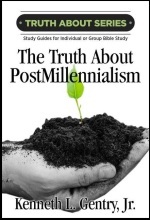 By Ken Gentry
By Ken Gentry
A group Bible study guide for explaining the optimistic prophetic hope for this world to be accomplished before Christ’s Second Coming. Establishes the postmillennial system in both the Old and New Testaments. Touches on key eschatological issues, such as creation, covenant, interpretive methodolgy, the great tribulation, the Book of Revelation, the Jewish Temple, and more. It presents and answers the leading objections to postmillennialism.Twelve chapters are ideal for one quarter of Sunday School.
See more study materials at: www.KennethGentry.com
Nonreductive physicalism goes further and denies not only a soul- ish intermediate state but the very concept of a distinct soul in human constitution, period. Nonreductive physicalists read the diverse terms body, soul, and spirit to refer aspectively, rather than partitively, to a human being. James D. G. Dunn describes the difference:
“In simplified terms, while Greek thought tended to regard the human being as made up of distinct parts, Hebraic thought saw the human being more as a whole person existing on different dimensions. As we might say, it was more characteristically Greek to conceive of the human person ‘partitively,’ whereas it was more characteristically ‘Hebrew’ to conceive of the human person ‘aspectively.’ That is to say, we speak of a school having a gym (the gym is part of the school); but we say I am a Scot (my Scottishness is an aspect of my whole being).”
Nonreductive physicalism asserts the human being on earth is wholly physical, and there is nothing that can then transverse the experience of death and enjoy a future phase of divine paradise apart from bodily life. The biblical evidence gestures otherwise, however. I leave to the side here the broader question of body-soul dualism and focus more on the question of an intermediate state. While the New specifically Testament does not riff widely or in detail on the nature of an intermediate state, it does pressure us to affirm that such a state exists in some fashion and with at least some definition. See how Christ responded to one of the thieves executed with him on Golgotha (as described in Luke 23:39–43). One criminal mockingly pressed Jesus to save them. The other criminal rebuked the first and affirmed the innocence of Jesus. Turning to Jesus, he implored: “Jesus, remember me when you come into your kingdom.” Jesus replied, “Truly I say to you, today you will be with me in paradise” (Luke 23:42–43).
 The Truth about Salvation By Ken Gentry
The Truth about Salvation By Ken Gentry
A study guide for personal or small group Bible study. Deals with the Christian doctrine of salvation from a Reformed theological perspective. It opens with a study of God as loving Creator, the shows how the first man fell into sin. Shows God’s righteousness requires that sin be dealt with. Presents Jesus as both God and man so that he can be man’s Savior. Includes review questions and questions for further study.Twelve chapters are ideal for one quarter of Sunday School.
See more study materials at: www.KennethGentry.com
The intermediate state is not the final state. It is a good gift and can be called “paradise,” yet it is not perfection. Why say it is imperfect? It is sinless and good, but it is not yet the complete or total culmination of all things; perfection here would mean wholistic completion or final attainment of the world’s full and fitting end. The intermediate state is immaculate, yet it has not attained that final intended reality. The conclusion to Hebrews 11 addresses the fate of Old Testament believers, all of whom had died prior to the writing of that epistle. “These were all commended for their faith, yet none of them received what had been promised, since God had planned something better for us so that only together with us would they be made perfect” (Heb 11:39–40). These saints were commended, but they had not yet received the promise or been “made perfect” (a term that connotes not sinlessness but maturity or completion; see also Heb 5:14). Perfection or wholeness only comes when all the redeemed experience it together; the words “together with are crucial in this regard. So, the intermediate state is good and even Paradise, but it is not the best and final state.
The Bible commends some notion of an intermediate state, which involves discontinuity and continuity with respect to our final destiny. There is an elemental continuity in that the spiritual presence of Almighty God, as well as the communion of the saints, may be enjoyed. And yet not yet that interpersonal fellowship exists in a wholly spiritual state that is resurrected or environmentally situated in a new heaven and new earth We can define the intermediate state only in very broad strokes. It involves the enjoyment of God’s presence, occurs in a temporarily disembodied state, is paradisal in character (as opposed to purgatorial in mood), and is not yet the climactic finale of redemptive history.
[image error]Why I Left Full-Preterism (by Samuel M. Frost)
Former leader in Full Preterist movement, Samuel M. Frost, gives his testimony and theological reasoning as to why he left the heretical movement. Good warning to others tempted to leave orthodox Christianity.
See more study materials at: KennethGentry.com
We should return to the challenge of nonreductive physicalism and its psychosomatic approach to human identity. The apostolic portrayal of the intermediate state in no way limits us from affirming that psychosomatic wholeness marks the perfection or completeness of human identity. Hebrews 11 suggests that no saint receives the promise or perfection until they do so with all the redeemed (in their resurrection state upon the return of Christ). The resurrected and glorified body in the new heavens and new earth remains the consummation of our Christian hope, though neither embodiment nor environmental location is the most significant marker of that glory. God’s presence is the prime and central thread in human happiness, and it will be most fully experienced when framed by bodily, indestructible life and by a restored, earthly context.
Gentry concluding note:
To read his full presentation including footnotes, consult the book Four Views on Heaven.
Click on the following images for more information on these studies:



April 15, 2025
WHY FOCUS ON MATTHEW’S DISCOURSE?
PMW 2025-029 by Kenneth L. Gentry, Jr.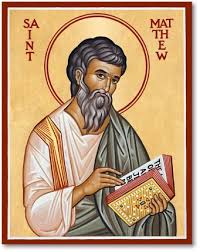
The “Olivet Discourse” is known by scholars as the “Eschatological Discourse.” This title focuses on its content, not its context; on what it teaches, not on where it was given. Though this fundamental Discourse appears in all three of the Synoptics (Matt. 24–25; Mark 13; Luke 21), in this posting I will explain why I focus on Matthew’s version of the Olivet Discourse in my research. I will present seven important reasons.
First, Matthew’s version is in the most Jewish Gospel
“It is agreed on all hands that this is a very “‘Jewish’ Gospel” (Leon Morris). This is significant in that the Discourse is sparked by deeply Jewish concerns raised by the Lord’s disciples (Matt. 24:1–3; cp. Mark 13:4). This includes highlighting the Jewish temple (“holy place,” v. 15; cp. vv. 1–2), its geographical setting in Judea (v. 16), and a distinctly Jewish Sabbath concern (v. 20). Robinson declares that “Matthew is more concerned than any other evangelist with the relationship of Christianity to the temple, the priesthood and the sacrifices” (J. A. T. Robinson).
Grant Osborne notes that “Matthew writes a Jewish gospel,” because he “especially had the Jewish Christian church and the Jewish people in mind.” John Nolland speaks of “the profound Jewishness of the whole of the Gospel of Matthew,” reminding us that it is “often and truly described as the most Jewish of the Gospels.” Darrell Bock writes that Matthew “is the one most focused on Jewish issues and concerns.” Robert Gundry speaks of “the profound Jewishness of the whole of the Gospel of Matthew.”
As I have argued elsewhere, Matthew presents a quite negative view of first-century Israel. And the Olivet Discourse forms the very climax to this negative angle in his teaching. Thus, the Discourse finds its fuller context in its setting in the whole Gospel. It should be helpful, therefore, to consider the Jewish nature of Matthew’s presentation of Olivet.
Olivet Discourse Made Easy (by Ken Gentry)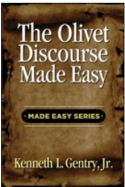
Verse-by-verse analysis of Christ’s teaching on Jerusalem’s destruction in Matt 24. Shows the great tribulation is past, having occurred in AD 70, and is distinct from the Second Advent at the end of history. Provides exegetical reasons for a transition from AD 70 to the Second Advent at Matthew 24:36.
See more study materials at: www.KennethGentry.com
Second, Matthew’s version is in the most influential Gospel
Though many scholars argue for Marcan Priority, the evidence from the early church Fathers strongly suggests Matthew was the first Gospel produced. [1] Because of this, Matthew was the most influential Gospel in the early church, being the one most cited by the Fathers. As ISBE2 (3:280) notes: “The Gospel of Matthew dominated the attention of the early Church, at least so far as the Synoptic Gospels are concerned, to the extent that it all but eclipsed the others.”
Matthew still remains the most influential of the three Synoptic Gospels even today. Osborne notes to this end: “Matthew has always been the gospel most widely read and the one first consulted for details about the life of Christ.” As one major Bible encyclopedia comments: “The Gospel according to Matthew has always occupied a position of highest esteem in the faith and life of the Christian church…. It may be that the early Christians placed it in first position in the NT canon precisely because of the profound influence of its contents” (ZEB 4:131).
Third, Matthew’s version appears climactically as Jesus’ final discourse
A well-known feature of Matthew is its highlighting five major discourses: the Sermon on the Mount (Matt. 5–7), the Missionary Discourse (Matt. 10), the Kingdom Parables (Matt. 13), the Community Life Discourse (Matt. 18), and finally the dramatic Olivet Discourse (Matt. 24–25). (Interestingly, of Jesus’ five major Discourses in Matthew, only the Sermon on the Mount [Matt. 5:1; 8:1] and the Olivet Discourse [Matt. 24:3] specify a mountainous location). As Osborne observes: “Matthew has structured his gospel very differently from the others and organized it around the five discourse units.” Each one of these ends with: “when he had finished these words” (Matt. 8:1; 11:1; 13:53; Matt. 19:1). But as Gibbs points out, Matthew inserts a “summarizing addition of ‘all’ to it transitional formula” at Matt. 26:1, which concludes the five discourses: “when Jesus had finished all these words.”
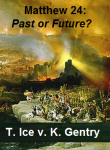
Matthew 24 Debate: Past or Future?
(DVD by Ken Gentry and Thomas Ice)
Two hour public debate between Ken Gentry and Thomas Ice on the Olivet Discourse.
See more study materials at: www.KennethGentry.com
As Christ’s last large-scale, formal instruction, it powerfully serves as the climax to his whole teaching ministry. Thus, it gives us insights into his ministry to Israel, which ministry was rejected by the nation as a whole (Matt. 23:37; 27:25). Olivet, therefore, serves as the Lord’s final warning to Israel.
However, Jesus is not merely a Jewish sage with a narrow, local, ethnic focus. The first part of the Discourse focuses on Jerusalem and the temple (Matt. 24:4–34). But this focus also provides a springboard for his warning of the Final Judgment of “all the nations” (Matt. 25:32), which is his concern in Matt. 24:37–25:46. I will provide a thorough exegetical argument for this in ch. 9.
Jeannine Brown well argues that “Jesus’ teachings turn from the signs portending the temple’s imminent destruction (24:4–35) to his reappearing (his parousia at the end of the age [see 24:3]), which will occur without warning (24:36–51).” This is significant in that as Jesus’ ministry unfolds to its end, Israel is turning more vehemently against him. This opens the door for the nations, which is the goal of the Gospel in its final verses containing the Great Commission (Matt. 28:18–20; contra Matt. 10:5–6; 15:24).
Fourth, Matthew’s version is the longest in the Synoptic Gospels
Matthew devotes two whole chapters of ninety-seven verses to Olivet. The second longest version is Mark’s, which is much shorter being contained within one chapter of only thirty-seven verses. The fuller record of the Lord’s instruction should be helpful to better understanding that teaching. Plus this gives us more material to analyze as we seek a better understanding of this important Discourse.
This also fits well with the observation that Matthew’s Gospel has a negative approach to first-century Israel. As Bock well notes: “For Matthew, Jesus’ relationship to Israel and explaining Israel’s rejection are major concerns.” Thus, Matthew’s longer Discourse denouncing Israel shows his great interest in Jesus’ judgment against her.
Understanding the Olivet Discourse 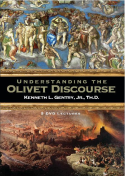
By Ken Gentry
This 5 DVD lecture set was filmed at a Bible Conference in Florida. It explains the entire Olivet Discourse in Matt. 24–25 from the (orthodox) preterist perspective. This lecture series begins by carefully analyzing Matt. 24:3, which establishes the two-part structure of the Discourse. It shows that the first section of the Discourse (Matt. 24:4–35) deals with the coming destruction of the temple and Jerusalem in AD 70. This important prophetic event is also theologically linked to the Final Judgment at the end of history, toward which AD 70 is a distant pointer.
For more educational materials: www. KennethGentry.com
Fifth, Matthew’s version has the fullest historical introduction
The Discourse appears just after Jesus’ calling down seven woes upon the scribes and Pharisees, which finally demonstrates the failure of Israel’s leadership and the doom that awaits them. In Matthew the woes consume an entire chapter of thirty-nine verses (Matt. 23:1–39). But in Mark the woes are summarized in only three verses (Mark 13:41–44).
Literary context is an essential aid to proper interpretation. In their highly-regarded work on interpretation, Walter Kaiser and Moises Silva urge: “Do emphasize the context. This is the fundamental principle. It is in fact the guideline that undergirds all of the others…. Before tackling a specific problem in one verse, we ought to read and reread the whole chapter — indeed, the whole book of which it is a part.”
Osborne provides a study of how to determine meaning in a text. He notes several errors of interpretation arising from focusing on smaller units of meaning: “Ignoring the Context. In one sense this is the basic error that encompasses the others and makes them possible…. The failure to note context may be the most frequently occurring error.” Robert Thomas notes that “traditional interpretation has consistently insisted on the importance of context in determining the meaning of a word or passage.”
Sixth, Matthew’s version has the fuller question of the disciples
Matthew’s record of their question contains sixteen words in the Greek (Matt. 24:3). And though Mark’s version has about the same number with fourteen words (Mark 13:4), Matthew’s version contains two distinct terms that cast more light on the matter: the Greek word parousia (“coming, presence”) and the Greek noun sunteleia (“completion, close, end”).
Seventh, Matthew’s version has the clearest literary structure
In Matthew 24:3 the disciples ask two questions. Due to their confusion, they believe their double question applies to the same, singular historical era. They do not realize the components of their double question refers to two historically-distinct eras.
Following J. M. Kik, R. T. France, J. A. Gibbs, David Garland, J. K. Brown, and others, the transition passage in Matt. 24: 34–36 provides powerful evidence that Jesus is shifting his attention from their first question to their second, from one topic to another. He is turning from the sign-filled (e.g., vv. 5–8, 25), near-term (Matt. 24:34) destruction of the temple (cf. Matt. 24:2) in AD 70 to the sign-less (Matt. 24:36, 39, 42, 44), historically-distant (Matt. 24:48; 25:5, 19) Final Judgment at the Last Day (cf. Matt. 25:31–46).
Jesus employs a significant transition marker to this end: he uses the prepositional phrase peri de (“now concerning”). In his Exegetical Guide to Matthew, Quarles points out that peri de with the gen[itive] … prob[ably] marks a major shift in topic in the discourse… De marks the next development in the discourse and the peri phrase announces the new topic.” Thus, as Gibbs notes, “the prepositional phrase at the beginning of 24:36. . . provides the hinge on which Jesus’ Eschatological Discourse turns from its first half (24:4–35) to its second (24:36–25:46).”
Notes
1. For a helpful defense of the priority of Matthew, see Robert L. Thomas and F. David Farnell, The Jesus Crisis: The Inroads of Historical Criticism into Evangelical Scholarship (Grand Rapids: Kregel, 1996). Gary W. Derickson, “Matthean Priority/ Authorship and Evangelicalism’s Boundary,” TMSJ (Spring 2003): 14:1: 87–103. See also Jeffrey A. Gibbs, Matthew 1:1–11:1 (St. Louis: Concordia, 2006), 64–66.
Click on the following images for more information on these studies:

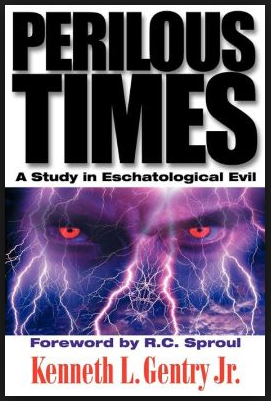
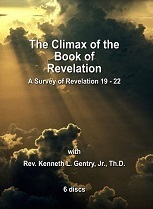
April 11, 2025
A SUMMARY OF MILLENNIAL VIEWS
PMW 2025-028 by Greg L. Bahnsen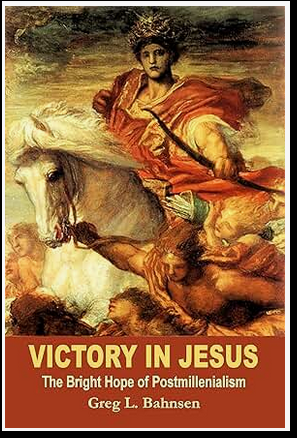
Gentry note: The following material is taken from Greg L. Bahnsen’s valuable study, “The Prima Facie Acceptability of Postmillennialism,” which is reprinted in his posthumously published collection of articles and lectures on postmillennialism as the book: Victory in Jesus: The Bright Hope of Postmillennialism. I highly recommend this book as a brief introduction to postmillennialism. The following is by Dr. Bahnsen.
The Distinctive Essentials of the Three Positions
In the preceding section of this discussion there was occasion to note that postmillennialism had been misrepresented in its basic position. This causes us to ask, just what are the fundamental differences among premillennialism, amillennialism, and postmillennialism? That is, what is the distinctive outlook of each position, its essential and central characteristic?
Here many people are prone to be misled, becoming entangled in questions which are subsidiary and indecisive with respect to the basic dogmatical outlook of a pre-, a-, and postmillennialism. What this means is that they take important exegetical issues pertaining to the millennial question and attempt to use them to delineate the three fundamental theological positions; however, these particular exegetical issues are not decisive for the central and general claims of the school of thought. Perhaps some examples would be helpful.
When we come to discuss the distinctive essentials of premillennialism, amillennialism, and postmillennialism, there are many interpretative questions pertaining to scriptural teaching about the millennium which, while very important for the Christian to consider, are not definitionally crucial at this particular topical point; that is because adherents of different basic schools of thought have agreed on particular answers to these questions. For instance, we can ask about the nature of the “first resurrection” of Revelation 20:5. Does it refer to a bodily resurrection, the regeneration of the believer, or his passage at death to the intermediate state in heaven? Such a question usually separates premillennialists from the other two positions, since premillennialism insists on the first option; however, adherents of both amillennialism and postmillennialism have been known to endorse each of the last two options. Likewise, the question of the imminency of Christ’s return tends to be answered in a cross-categorical manner; some premillennialists deny it in practice (post-tribulationists), while others propound it, just as amillennialists are split by those who accept it and those who reject it.
[image error]Why I Left Full-Preterism (by Samuel M. Frost)
Former leader in Full Preterist movement, Samuel M. Frost, gives his testimony and theological reasoning as to why he left the heretical movement. Good warning to others tempted to leave orthodox Christianity.
See more study materials at: KennethGentry.com
The question does not serve us well in the particular project of finding the distinctive essentials of each of the three eschatological schools. Further subsidiary or theologically indecisive issues would pertain to such things as whether the Christian martyrs receive a special blessing during the millennium, whether the millennium pertains to the intermediate state at all (amillennialists and postmillennialists have agreed in various ways on this question), whether the church is an expression of Christ’s kingdom (recent premillennialists have come to grant this point), whether a future period of unprecedented tribulation with a personal Anti-Christ awaits the world and/or church (all three positions have espoused, or can accommodate, such an opinion), whether the “one thousand” of Revelation 20 is symbolic or literal (again, all three positions have or could answer this both ways). Such questions as these are of momentous significance for the Christian in his faith and practice, and this writer has definite convictions on each one of them. However, these issues and many more like them are not the telling differences among the three theological schools of premillennialism, amillennialism, and postmillennialism.
In order to get down to the really basic differences among these three positions as distinct schools of thought we can begin by outlining their respective central claims.
Premillennialism
Premillennialism holds that (1) Christ will return physically prior to the millennium, and that (2) the millennium is a period of righteousness, peace and prosperity for Christ’s kingdom on the earth. There will be (3) a significant historical delay or gap between the return of Christ at the first resurrection and the judgment of the wicked at the second resurrection, just prior to the inauguration of the eternal state. (This gap corresponds to the millennial kingdom of earthly prosperity for God’s chosen people.) Therefore, (4) the millennium is distinct from the current church age, being a future interim period between Christ’s return and the final judgment.
(5) The specific nature of the millennial kingdom will be seen in the national prosperity of the restored Jewish state with Christ ruling bodily from Jerusalem and militarily subduing the world with the sword. (However, some premillennialists de-emphasize this Jewish element and simply stress that the millennium is a preparatory stage for the church; the Old Testament nation, the New Testament church, the millennium, and the eternal state are all seen as developing stages in the kingdom.) Thus, (6) the Old Testament prophecies of prosperity are required to be taken literally as pointing ahead to a Jewish state separate from the church and necessitating a radical discontinuity between Israel and the church. Finally, (7) the church’s preaching of the gospel through the whole earth prior to Christ’s return will prove to be of no avail culturally; the world will become a hopeless wreck, increasingly getting worse and worse, climaxing in the tribulation at the very end of the church age.
House Divided: The Break-up of Dispensational Theology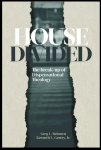 By Greg Bahnsen and Ken Gentry
By Greg Bahnsen and Ken Gentry
This book presents and defends Christian Reconstruction theology, particularly theonomic ethics and postmillennial eschatology. It does to by responding to dispensationalism’s social and exegetical theology.
For more educational materials: www. KennethGentry.com
Amillennialism
By contrast, amillennialism says that (1) Christ will return after the millennium. (2) It maintains that there will be no millennium in the sense of a semi-golden era of earthly prosperity for the kingdom; instead, the millennium is restricted to the blessings of the intermediate (heavenly) state (some restricting its blessing to the martyrs there) and/or the purely inward spiritual triumphs experienced by the church on earth (i.e., Christ ruling in the believer’s heart). Basically then, amillennialism denies that there will be any visible or earthly expression of Christ’s reign over the entire world; as D. H. Kromminga says, “the millennium is a spiritual or heavenly millennium.” (Note: the church is a visible form of Christ’s kingdom in the world, according to many amillennialists; however, the church will not make all the nations disciples of Christ and gain a dominant or widespread influence throughout the world, but will rather remain a remnant of believers representatively spotted across the globe, which is unable to effect a period of [comparative] justice and peace.)
(3) The return of Christ at the end of the church age will synchronize with the general resurrection and general judgment of all men, believer and unbeliever alike. Therefore, (4) the millennium is the present interadventual age. (5) There will be no conversion or subduing of the world by Christ during the millennium, but rather the world will see a more or less parallel development of good and evil, with evil intensifying toward the end of the church age. Thus (6) the Old Testament prophecies of prosperity are required to be taken completely figuratively as pointing ahead to the eternal state or the internal spiritual condition of the church, thus propounding continuity between Old Testament Israel and the New Testament church. Finally, (7) the world is moving toward a time of increasing lawlessness, and the preaching of the gospel throughout the world will not achieve outstanding and pervasive success in converting sinners (i.e., the overall discipling of the nations).
Postmillennialism
Postmillennialism, as the name implies, holds that (1) Christ will return subsequent to the millennium, which (2) represents a period which will see growth and maturation of righteousness, peace, and prosperity for Christ’s kingdom on earth (visibly represented by the church) through the gradual conversion of the world to the gospel, as well as a period for the glory and vindication of the saints in heaven. (3) The return of Christ will synchronize with the general resurrection and general judgment at the end of the church age.
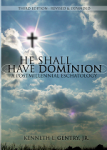
He Shall Have Dominion
(paperback by Kenneth Gentry)
A classic, thorough explanation and defense of postmillennialism (600+ pages). Complete with several chapters answering specific objections.
See more study materials at: www.KennethGentry.com
Therefore, (4) the millennium or kingdom of millennialists have used the eschatological vocabulary in such a way that the “millennium” represents the latter day, publicly discernible, prosperity of the interadventual “kingdom.”) (5) The specific nature of the millennial kingdom on earth will be the international prosperity of the church (new Israel), its growth (through the conversion of the world by the sword of the Spirit), and its influence in society and culture. Thus, (6) the Old Testament prophecies of prosperity for the kingdom are both figuratively and literally interpreted according to the demands of context (both local and wider) as pointing ahead not simply beyond the church age to a restored Jewish kingdom or the eternal state (thus rendering the visible church on earth something of a parenthesis for the most part), but to the visible prosperity of Christ’s established kingdom on earth, climaxing in the consummated glory of the eternal state; there is continuity between Old Testament Israel and the New Testament Church (new Israel), which eventually will include the fullness of converted physical Israel grafted back into the people of God.
Finally then, (7) over the long range the world will experience a period of extraordinary righteousness and prosperity as the church triumphs in the preaching of the gospel and discipling the nations through the supernatural agency of the Holy Spirit; however, the release of Satan at the very end of the age will bring apostasy from these blessed conditions.
To finish reading this material in full (with footnotes) check out the book at Amazon.
GOODBIRTH AND THE TWO AGES
I am currently researching a technical study on the concept of the Two Ages in Scripture. This study is not only important for understanding the proper biblical concept of the structure of redemptive history. But it is also absolutely essential for fully grasping the significance of the Disciples’ questions in Matthew 24:3, which spark the Olivet Discourse. This book will be the forerunner to a fuller commentary on the Olivet Discourse in Matthew’s comprehensive presentation. This issue must be dealt with before one can seriously delve into the Discourse itself.
If you would like to support me in my research, I invite you to consider giving a tax-deductible contribution to my research and writing ministry: GoodBirth Ministries. Your help is much appreciated!
April 8, 2025
IMPORTANCE OF BODILY RESURRECTION
PMW 2025-027 by Ben Witherington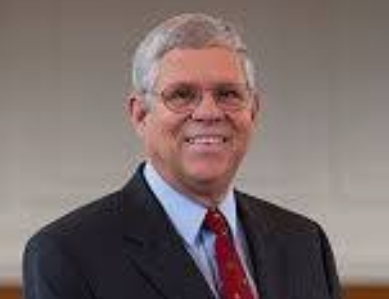
Gentry note: As I continue daily research for my next book, I have stumbled on a helpful one titled Jesus, Paul and the End of the World by Ben Witherington (IVP 1992). Dr. Witherington is Professor of New Testament Interpretation at Asbury Theological Seminary and a widely recognized scholar who has written over sixty books on a variety of biblical issues and from leading evangelical publishers. Although I do not endorse everything he states in this work, he has many valuable, well-researched, deeply-exegetical insights that have been profitable for me. This is only an excerpt from pages 187–191 of this work. There is a lot of surrounding context that is necessary for grasping the full force of his argument. But this ought to whet your appetite. And steer you clear from the proto-Gnosticism of hyper-preterists who see the resurrection body as an ethereal, spiritual reality rather than a corporeal, material one.
That which follows is by Witherington and is cited from his from Jesus, Paul and the End of the World:
In 1 Thessalonians 1:10 Christ’s resurrection is connected with the believer’s future deliverance from God’s wrath. In fact, almost always when Paul speaks of Christ’s resurrection he does so in connection with the events that will transpire when Christ returns. He clearly does not see Christ’s resurrection as an isolated historical anomaly but as an eschatological event that is the harbinger and in some sense the trigger or at least the prerequisite of future eschatological events. Paul is surely dealing with Christians in Thessalonica who had speculated about such eschatological matters, and it may even be that the Thessalonian Christians were reflecting the characteristics of a millenarian movement. If so, then it would appear that Paul is trying to offer a certain amount of “eschatological reserve” while still affirming much of the substance of the Thessalonians’ beliefs about the future. Here Paul grounds the believer’s future status in the belief in the past Christ-event.
I have already dealt with 1 Thessalonians 4:14 in the previous chapter but note here that the future resurrection of deceased believers is linked with the past death and resurrection of Jesus. The link here, however, is unlike that in 1 Corinthians 15. Here belief in Christ’s resurrection is seen as the proper grounds for believing that deceased Christians will likewise be raised. Verse 16 also makes clear that Paul is only referring to the future of “the dead in Christ,” that is, dead Christians. Christ’s resurrection is not a guarantee or proof of the future general resurrection of all the dead. Finally, since in verse 17b Paul says “and so [or ‘in this way’– kai houtōs] we shall be with the Lord forever [pantote],” this must count strongly against the idea that this text is talking about some interim stay with Christ in heaven during a period of earthly tribulation.
GOODBIRTH AND THE TWO AGES
I am currently researching a technical study on the concept of the Two Ages in Scripture. This study is not only important for understanding the proper biblical concept of the structure of redemptive history. But it is also absolutely essential for fully grasping the significance of the Disciples’ questions in Matthew 24:3, which spark the Olivet Discourse. This book will be the forerunner to a fuller commentary on the Olivet Discourse in Matthew’s comprehensive presentation. This issue must be dealt with before one can seriously delve into the Discourse itself.
If you would like to support me in my research, I invite you to consider giving a tax-deductible contribution to my research and writing ministry: GoodBirth Ministries. Your help is much appreciated!
This brings up a very crucial point that I shall develop at length when we turn to 1 Corinthians 15, but it bears mentioning here. For Paul resurrection means final conformity to the likeness or image of God’s Son, even in regard to one’s body. In other words, resurrection seems to have a very specific positive content that has to do with the consummation of Paul’s ideas about the imitatio Christi. In such a context it is hardly surprising that Paul never speaks of the resurrection of nonbelievers. If one has not participated in the process of being conformed to the image of the Son in this life (Rom 8:29), it is hardly to be expected that one would get the final installment or completion of this ongoing process later. Resurrection ushers the believer into the new world and the kingdom promised to them by God. Vos has it right when he says:
“If we may judge of the resurrection of believers mutatis mutandis after the analogy of that of Christ, we shall have to believe that the event will mark the entrance upon a new world constructed upon a new superabundantly dynamic plane. . . . The resurrection constitutes, as it were, the womb of the new aeon, out of which believers issue as, in a new, altogether unprecedented sense, sons of God…. The analogy and its bearing upon our problem become most clear when the passage Rom. 1:3–4 is somewhat closely analyzed…. The Resurrection (both of Jesus and of believers) is therefore according to Paul the entering upon a new phase of sonship characterized by the possession and exercise of unique supernatural power.”
The truth of this observation will become readily apparent when we examine Romans 1 and 1 Corinthians 15 more fully below. However, I submit that this theological truth already stands behind what Paul says in texts like 1 Thessalonians 3:13 and 5:23 where the ongoing process of sanctification is seen as preparation for the coming of Christ. The work of the Spirit in the present in the believer is preparing that believer not only for the final judgment of Christ, but for the final work of the Spirit for the believer, that is, resurrection in the likeness of Christ’s glorified body. For Paul, Christology, pneumatology, soteriology, eschatology and ethics are so closely interwoven that any attempt to treat one or another of these aspects of Paul’s thought in isolation from the others does less than justice to them all. This is especially true when we come to what is for Paul a sine qua non of Christian faith — the belief in both Christ’s and the believer’s resurrection.\
 The Book of Revelation and Postmillennialism (Lectures by Ken Gentry)
The Book of Revelation and Postmillennialism (Lectures by Ken Gentry)
In the first of these three 50-minute lectures Gentry explains Revelation’s judgments to show they do not contradict postmillennialism. In the next two lectures he shows how the Millennium and the New Creation themes strongly support the gospel victory hope found in postmillennialism.
See more study materials at: www.KennethGentry.com
One last aspect of Paul’s discussion in 1 Thessalonians 4:14–17 bears scrutiny. Resurrection here, as in 1 Thessalonians 1:10, has to do with something that happens to a dead person, not a living one. First Thessalonians 4:17 may imply that some similar transformation will happen to living believers but it is not called resurrection here. Since 2 Thessalonians adds nothing to our discussion, we will pass on to 1 and 2 Corinthians.
The first passage under consideration, 1 Corinthians 6:14, comes in the middle of Paul’s discussion about the proper use of the human body. Resurrection is introduced here to explain why it is important to act morally in and with the body — body is meant for the Lord and in fact will participate in the eschatological state of salvation. Verse 14 makes the analogy between Christ’s resurrection and that of believers quite explicit. Both are raised up by God’s power. The context makes clear that by resurrection Paul means something involving a body. In view of the future verb katargesei in verse 13, the future exegerei is surely to be preferred in verse 14 (compare 2 Cor 4:14). Again we see a clear connection made between the believer’s present condition and conduct and his future condition. Ethics circumscribes bodily conduct because the body has a place in the eschatological future of the believer. Paul is countering the “spiritualizing” tendencies of Corinthian eschatology and soteriology. “This affirmation stands in bold contrast to the Corinthian view of spirituality which looked for a ‘spiritual’ salvation that would finally be divested of the body.”
There has been much debate over what Paul is combating in 1 Corinthians 15. On the surface of things verse 12 seems to give a straightforward answer — some in Corinth were saying, “there is no resurrection of the dead.” Paul attributes this view to only “some” (tines), but these some were evidently sufficient in number and/or in importance in the Corinthian church for Paul to correct the problem in this letter to the church as a whole. Indeed, the space Paul devotes to this problem suggests that it is part of the larger general problem in Corinth of what may be called spiritualized eschatology, which Paul has been correcting all along in this letter.
House Divided: The Break-up of Dispensational Theology By Greg Bahnsen and Ken Gentry
By Greg Bahnsen and Ken Gentry
This book presents and defends Christian Reconstruction theology, particularly theonomic ethics and postmillennial eschatology. It does to by responding to dispensationalism’s social and exegetical theology.
For more educational materials: www. KennethGentry.com
Could these “some” be the same ones who were also baptizing for the dead? It is often pointed out that the practice of baptizing for the dead surely implies some hope about the future of the deceased ones for whom proxy baptism is being undertaken. Paul, by implication, certainly seems to think there is some connection, at least in the minds of those receiving this peculiar baptism, between this practice and one’s hope for the future of these deceased persons. What is not clear from verse 29 is whether that future hope entailed a hope for some sort of resurrection or rather some sort of less material participation in eternal life. Paul does not specifically identify the some who are denying the resurrection with “those” who are receiving proxy baptism.
It also seems reasonable to maintain that if Paul in 1 Corinthians 15:12 had future resurrection, he would have said anastasin ēdē gegonenai not anastasis ouk estin.
Perhaps the problem lies with the fact that we have overlooked the qualifier in verse 12 — what is being denied is not just “resurrection” simpliciter but resurrection of the dead (nekron). A. J. M. Wedderburn asserts “that ‘resurrection’ would mean, especially to Hellenistic readers, something physical, earthy, which only gradually came to be spiritualized as groups of Christians… sought to reconcile their Hellenistic or gnostic aversion to the body with the ineluctable of the idea of resurrection in … Christian tradition.”
However, there is evidence in 1 Corinthians that at least some of the Corinthians themselves already had been involved in such a spiritualizing of matters. Besides the fact that a case can be made for some proto-Gnostic tendencies in Corinth, if 1 Corinthians 6:13b is a quote of the Corinthian’s view that God will destroy the body, thus implying that salvation has nothing to do with it, or if in fact 1 Corinthians 4:8 ascribes to various Corinthians an overrealized, as well as an overly pneumatic, view of salvation in which the new life called by Christians “resurrection” is seen as a matter of life in the Spirit here and now, it is not hard to believe that some Corinthian Christians were denying “resurrection of the dead.” Wedderburn says, “For the Corinthians what they treasure as life-giving and divine is the pneuma specially granted to them and not the psyche which is in every [one].” Resurrection of dead persons might well have connoted to such Corinthians “the standing up of corpses” (see Acts 17:31–32). This would have seemed repugnant to those who saw salvation/new life in a purely spiritual vein, whether in this life or the next.
 The Beast of Revelation (246pp); Before Jerusalem Fell: Dating the Book of Revelation (409pp); Navigating the Book of Revelation: Special Studies on Important Issues (211pp).
The Beast of Revelation (246pp); Before Jerusalem Fell: Dating the Book of Revelation (409pp); Navigating the Book of Revelation: Special Studies on Important Issues (211pp).
In the Logos edition, these volumes by Ken Gentry are enhanced by amazing functionality. Important terms link to dictionaries, encyclopedias, and a wealth of other resources in your digital library. Perform powerful searches to find exactly what you’re looking for. Take the discussion with you using tablet and mobile apps. With Logos Bible Software, the most efficient and comprehensive research tools are in one place, so you get the most out of your study.
For more study materials, go to: KennethGentry.com
Thus we should not try to envision a group of Christians in Corinth who flatly denied “resurrection,” whether Christ’s or believers’ per se. Paul would hardly have addressed such persons as adelphoi (15:1), in view of how strongly he feels about resurrection being a sine qua non of Christian faith (see 15:12–19). Nor would he have reminded them that they had already believed in the resurrection if it were not so (15:11). Rather, he is trying here to correct an overly spiritual and an overrealized view of resurrection. He corrects the former by stressing that resurrection involves a body. He corrects the latter by setting forth a sketch of the order of future eschatological events, including resurrection of the dead. The Corinthians apparently thought the body was at best something inferior, temporary, of no eternal significance, and at worst some of them may have seen matter as tainted or even evil. In either case they did not envision eternal life/resurrection as involving a body. This is not surprising in an environment where the dominant idea of immortality was still the immortality of the soul. K. A. Plank sums up the matter well:
“The problem in Corinth is not the denial of the kerygma but its enthusiastic interpretation: the scandal of the crucified Messiah has been overcome by an through sacramental realism that understands redemption to have already uncontrolled exaltation christology; obedience to his lordship has been lost through sacramental realism that understands redemption to have already been effected. The difficulty is not the failure of the Corinthians to believe in the resurrection, Christ’s or their own, but the fact that they believed “too much”!… To oppose the Corinthian position and be true to his own Paul must be both “for and against a theology of the resurrection.”
Thus, ends Witherington citation. To read his full argument, purchase the book at: Amazon
Kenneth L. Gentry Jr.'s Blog
- Kenneth L. Gentry Jr.'s profile
- 85 followers



